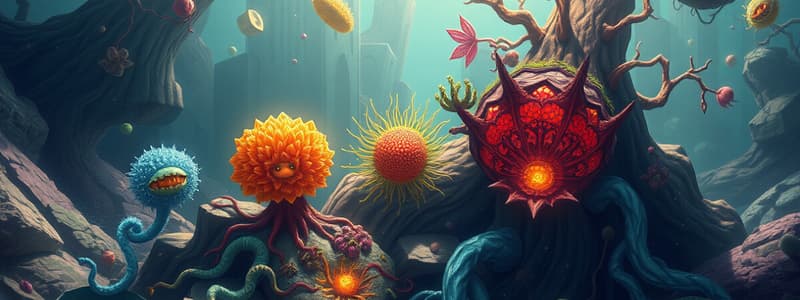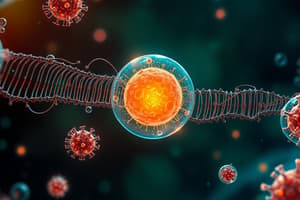Podcast
Questions and Answers
Which kingdom is characterized by prokaryotic cell types?
Which kingdom is characterized by prokaryotic cell types?
- Animalia
- Monera (correct)
- Plantae
- Fungi
What is a unique feature of the cell wall in the Fungi kingdom?
What is a unique feature of the cell wall in the Fungi kingdom?
- It is absent.
- It is made of cellulose.
- It is composed of peptidoglycan.
- It contains chitin. (correct)
Which of the following characteristics is true for the Animalia kingdom?
Which of the following characteristics is true for the Animalia kingdom?
- They lack a nuclear membrane.
- They are autotrophic.
- They are heterotrophic. (correct)
- They have a prokaryotic cell type.
In which kingdom are organisms primarily unicellular and eukaryotic?
In which kingdom are organisms primarily unicellular and eukaryotic?
What type of nutrition is primarily associated with Plantae?
What type of nutrition is primarily associated with Plantae?
What distinguishes the modes of nutrition in the Fungi kingdom?
What distinguishes the modes of nutrition in the Fungi kingdom?
Whittaker's five-kingdom classification excludes which of the following criteria?
Whittaker's five-kingdom classification excludes which of the following criteria?
Flashcards are hidden until you start studying
Study Notes
Five Kingdom Classification
- Proposed by R.H. Whittaker in 1969, encompassing Monera, Protista, Fungi, Plantae, and Animalia.
- Classification criteria include cell structure, body organization, mode of nutrition, reproduction, and phylogenetic relationships.
Characteristics Overview
-
Monera
- Cell Type: Prokaryotic.
- Cell Wall: Noncellulosic composed of polysaccharides and amino acids.
- Nuclear Membrane: Absent.
- Body Organization: Cellular.
- Mode of Nutrition: Autotrophic, including both chemosynthetic and photosynthetic methods.
-
Protista
- Cell Type: Eukaryotic.
- Cell Wall: Present in some organisms.
- Nuclear Membrane: Present.
- Body Organization: Cellular.
- Mode of Nutrition: Primarily heterotrophic.
-
Fungi
- Cell Type: Eukaryotic.
- Cell Wall: Composed of chitin.
- Nuclear Membrane: Present.
- Body Organization: Multicellular or loose tissue.
- Mode of Nutrition: Heterotrophic, mainly saprophytic.
-
Plantae
- Cell Type: Eukaryotic.
- Cell Wall: Composed of cellulose.
- Nuclear Membrane: Present.
- Body Organization: Organized into tissues, organs, and organ systems.
- Mode of Nutrition: Autotrophic, primarily photosynthetic.
-
Animalia
- Cell Type: Eukaryotic.
- Cell Wall: Absent.
- Nuclear Membrane: Present.
- Body Organization: Organized into tissues, organs, and organ systems.
- Mode of Nutrition: Heterotrophic, encompassing holozoic and saprophytic methods.
Six Kingdom Classification
- An alternative classification is the three-domain system.
- This system divides Monera into two distinct domains.
- Remaining eukaryotic kingdoms are classified within a third domain, effectively creating a six kingdom classification.
Studying That Suits You
Use AI to generate personalized quizzes and flashcards to suit your learning preferences.




